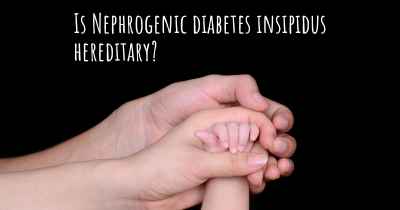Which are the causes of Nephrogenic diabetes insipidus?
See some of the causes of Nephrogenic diabetes insipidus according to people who have experience in Nephrogenic diabetes insipidus

Nephrogenic diabetes insipidus (NDI) is a rare disorder characterized by the inability of the kidneys to properly concentrate urine, leading to excessive thirst and frequent urination. Unlike central diabetes insipidus, which is caused by a deficiency of the hormone vasopressin, NDI is primarily a result of the kidneys' inability to respond to vasopressin. This condition can be either acquired or inherited, and its causes can vary.
Causes of Nephrogenic Diabetes Insipidus
1. Genetic Mutations: Inherited forms of NDI are caused by mutations in specific genes that are involved in the regulation of water balance in the kidneys. The most common genetic cause of NDI is a mutation in the AVPR2 gene, which encodes the vasopressin receptor in the kidneys. Mutations in the AQP2 gene, which is responsible for the production of a water channel protein in the kidneys, can also lead to NDI.
2. Medications: Certain medications can cause acquired NDI. Lithium, a commonly used medication for bipolar disorder, is a well-known cause of NDI. Prolonged use of lithium can impair the kidneys' ability to respond to vasopressin, leading to the development of NDI. Other medications, such as certain diuretics and antiviral drugs, have also been associated with the development of NDI.
3. Chronic Kidney Disease: Chronic kidney disease (CKD) can lead to acquired NDI. The progressive damage to the kidneys in CKD can impair their ability to respond to vasopressin, resulting in NDI. This can occur due to various underlying causes of CKD, such as diabetes, hypertension, autoimmune diseases, and certain infections.
4. High Calcium Levels: Hypercalcemia, a condition characterized by abnormally high levels of calcium in the blood, can cause acquired NDI. Elevated calcium levels can interfere with the kidneys' response to vasopressin, leading to impaired water reabsorption and the development of NDI.
5. Obstructive Uropathy: Obstructive uropathy refers to any condition that obstructs the normal flow of urine, such as kidney stones, tumors, or an enlarged prostate. Prolonged obstruction can damage the kidneys and impair their ability to concentrate urine, resulting in NDI.
6. Other Factors: There are several other factors that can contribute to the development of NDI. These include certain genetic disorders like sickle cell disease, polycystic kidney disease, and amyloidosis. Additionally, electrolyte imbalances, such as low potassium levels, can also affect the kidneys' response to vasopressin and lead to NDI.
Conclusion
Nephrogenic diabetes insipidus can have various causes, both inherited and acquired. Genetic mutations in genes involved in water balance regulation, medications like lithium, chronic kidney disease, high calcium levels, obstructive uropathy, and other factors can all contribute to the development of NDI. It is important to identify the underlying cause of NDI to determine the appropriate treatment and management strategies for individuals affected by this condition.
Posted Mar 7, 2017 by Mason 1050
Posted Mar 4, 2017 by Marina 1000








